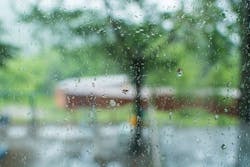Rainwater harvesting can be a powerful tool to reduce the strain on aging water supply and storm water infrastructure, but to fully utilize this tool, we need to begin to take it more seriously as infrastructure. When a city looks for new water supply options, they often consider new reservoirs, reclaimed water, a new groundwater well and other centralized structures. When combatting storm water runoff, decentralized solutions like rainwater harvesting are given more attention in new construction.
Requirements for on-site storm water management are incorporated into overall municipal planning for storm water, and municipalities often offer financial incentives for on-site storm water management. However, many municipalities still turn to large centralized approaches to combat combined sewer overflows and address overall challenges to the storm water system.
A Cost-Effective Solution
A 2015 study examined the impacts and cost-effectiveness of using rainwater harvesting to reduce combined sewer overflows in Toledo, Ohio. The study modeled the lifecycle costs and reduction in combined sewer overflows of four scenarios: the city’s gray infrastructure overflow control plan, which includes improvements to the wastewater treatment plant and larger capacity sewer mains; a plan solely based on the implementation of rainwater harvesting systems; a plan combining rainwater harvesting and gray infrastructure across the whole study area; and a hybrid plan based on a strategic combination of gray infrastructure in some areas of the city and rainwater harvesting in other areas.
The study found that using rainwater harvesting systems alone was low-cost but also had limited effectiveness in reducing combined sewer overflows. However, the hybrid approach improved the cost-effectiveness by 48% compared to the gray infrastructure plan. Cost-effectiveness was measured as a ratio of the lifecycle cost of the approach divided by the yearly volume reduction in combined sewer overflows. This approach, which strategically combined green and gray infrastructure, was highly effective at reducing combined sewer overflows at low cost.
The same group of researchers conducted a 2016 study using a similar approach and again examined combined sewer overflows in Toledo. They looked at predicted changes in combined sewer overflows due to increased rainfall depths and intensity due to climate change. They found that rainwater harvesting systems on 50% of the buildings in the city could alleviate the predicted increase in combined sewer overflows. As cities across the country plan for climate change, this type of scalable, cost-effective approach can be a robust strategy for mitigating the effects of changes in precipitation.
Rainwater Harvesting to Manage Storm Water
Rainwater harvesting systems can also mitigate flooding. A 2020 study examined the impacts if rainwater harvesting systems were installed on all buildings in Melbourne, Australia. The study found that these systems had limited impact on large flood events but significantly reduced the damage from small and medium flood events. Interestingly, while these smaller flood events obviously caused less damage per event, they actually accounted for a greater financial risk because of the increased frequency. Because of this, the rainwater harvesting systems could reduce the cost of flooding by as much as 30%, and in many of the scenarios explored in the paper, the economic benefits due to flood reduction alone were enough to offset the investment in the rainwater harvesting systems.
Widespread adoption of rainwater harvesting is not just a viable approach for storm water management. Research shows that rainwater harvesting can be a viable and cost-effective water supply alternative. A 2020 study modeled the impact of hypothetical installation of rainwater harvesting systems on buildings across New York City. The study examined four different scenarios representing a strategic mix of public and private funding for rainwater harvesting systems. Private funds were used to finance rainwater harvesting systems in which the modeled reduction in water costs over the 20 year period would be greater than the costs of the system, including maintenance and operations.
When rainwater harvesting was strategically implemented, with private funds supporting rainwater harvesting systems as described above and public funds used to support cost-effective rainwater harvesting systems (in which the cost per volume of water supplied over the 20 year modeled period was relatively low), the rainwater harvesting systems were able to supply between 15-30% of the city’s non-drinking water demand, usually at a lower cost than the centralized alternative.
This study demonstrates that strategic implementation of rainwater harvesting, supported by a public-private partnership, can be a wise economic decision for a municipality. Similarly, a 2019 study compared the cost of installing residential rainwater harvesting systems for outdoor irrigation as a means to increase local water supply to account for population growth in two Florida counties.
The hypothetical rainwater harvesting systems were able to supply as much as or more water than three out of four alternative centralized water supply solutions (desalination and two groundwater recharge options) at a lower cost per gallon. More importantly, the authors noted the rainwater harvesting systems could be implemented incrementally, with additional water supply capacity added as population grows. This flexibility prevents municipalities making large investments in water supply infrastructure for predicted population growth that does not occur.
Implementation in the Real World
Given this evidence of the benefits of widespread adoption of rainwater harvesting in cities, the question remains, why are these all hypothetical? Implementing a modeled scenario in real life undoubtedly has challenges. However, all of these studies demonstrate that large scale implementation of rainwater harvesting can provide cost-effective solutions to water supply and storm water challenges. These studies involve strategic selection of rainwater harvesting system storage size, location, and use with a more intentional implementation than is possible with current rebate and incentive plans.
Centralized water supply systems have improved public health and provision of safe, readily available drinking water has been a public health boon. But now that centralization comes at a cost, a diminished ability to adapt decentralized solutions. Improvements in technology make remote monitoring possible and allow improved water quality at decentralized water systems. Implementing these changes will not be trivial or simple, but it will be powerful.
One of the first steps towards this larger scale implementation is an assessment of the rainwater harvesting systems already in place. In my years of studying rainwater harvesting systems in the United States, I have been asked many times “how many rainwater harvesting systems are there?” and I have in turn asked many others this question. To my knowledge, no one knows within even a factor of 100 how many rainwater harvesting systems there are, how much water they supply annually and how much storm water they intercept.
A starting effort is a rainwater harvesting inventory – an attempt to list as many rainwater harvesting systems in the U.S. and Canada as possible. While this inventory will never be able to list every system, it will start to give a sense of what the systems are like – how big, what the water is used for, and how the water is treated. Not only will this facilitate incorporating these systems into larger planning, but it could also help guide research and regulator efforts by indicating what types of systems people want. If you would like to contribute information on a system to the inventory, please visit https://forms.gle/pS5ftG3qr7hFKWKw9.
References
- Tavakol-Davani, H., Burian, S. J., Devkota, J., & Apul, D. (2016). Performance and Cost-Based Comparison of Green and Gray Infrastructure to Control Combined Sewer Overflows. Journal of Sustainable Water in the Built Environment, 2(2), 04015009. https://doi.org/10.1061/JSWBAY.0000805
- Tavakol-Davani, H., Burian, S., Devkota, & Apul, D. (2016). Performance and cost-based comparison of green and gray infrastructure to control combined sewer overflows. Journal of Sustainable Water in the Built Environment, 2(2), 04015009.
- Jamali, B., Bach, P. M., & Deletic, A. (2020). Rainwater harvesting for urban flood management—An integrated modelling framework. Water Research, 171, 115372. https://doi.org/10.1016/j.watres.2019.115372
- van Dijk, S., Lounsbury, A. W., Hoekstra, A. Y., & Wang, R. (2020). Strategic design and finance of rainwater harvesting to cost-effectively meet large-scale urban water infrastructure needs. Water Research, 184, 116063. https://doi.org/10.1016/j.watres.2020.116063
- Wurthmann, K. (2019). Assessing storage requirements, water and energy savings, and costs associated with a residential rainwater harvesting system deployed across two counties in Southeast Florida. Journal of Environmental Management, 252, 109673. https://doi.org/10.1016/j.jenvman.2019.109673






